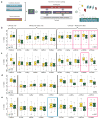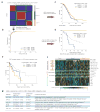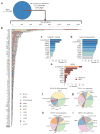Assessing the clinical utility of cancer genomic and proteomic data across tumor types
- PMID: 24952901
- PMCID: PMC4102885
- DOI: 10.1038/nbt.2940
Assessing the clinical utility of cancer genomic and proteomic data across tumor types
Abstract
Molecular profiling of tumors promises to advance the clinical management of cancer, but the benefits of integrating molecular data with traditional clinical variables have not been systematically studied. Here we retrospectively predict patient survival using diverse molecular data (somatic copy-number alteration, DNA methylation and mRNA, microRNA and protein expression) from 953 samples of four cancer types from The Cancer Genome Atlas project. We find that incorporating molecular data with clinical variables yields statistically significantly improved predictions (FDR < 0.05) for three cancers but those quantitative gains were limited (2.2-23.9%). Additional analyses revealed little predictive power across tumor types except for one case. In clinically relevant genes, we identified 10,281 somatic alterations across 12 cancer types in 2,928 of 3,277 patients (89.4%), many of which would not be revealed in single-tumor analyses. Our study provides a starting point and resources, including an open-access model evaluation platform, for building reliable prognostic and therapeutic strategies that incorporate molecular data.
Conflict of interest statement
The authors declare no competing interests.
Figures





Similar articles
-
Assessing the clinical utility of genomic expression data across human cancers.Oncotarget. 2016 Jul 19;7(29):45926-45936. doi: 10.18632/oncotarget.10002. Oncotarget. 2016. PMID: 27322207 Free PMC article.
-
Comparison of the Prognostic Utility of the Diverse Molecular Data among lncRNA, DNA Methylation, microRNA, and mRNA across Five Human Cancers.PLoS One. 2015 Nov 25;10(11):e0142433. doi: 10.1371/journal.pone.0142433. eCollection 2015. PLoS One. 2015. PMID: 26606135 Free PMC article.
-
Targeted DNA and RNA Sequencing of Paired Urothelial and Squamous Bladder Cancers Reveals Discordant Genomic and Transcriptomic Events and Unique Therapeutic Implications.Eur Urol. 2018 Dec;74(6):741-753. doi: 10.1016/j.eururo.2018.06.047. Epub 2018 Jul 20. Eur Urol. 2018. PMID: 30033047
-
PanCancer insights from The Cancer Genome Atlas: the pathologist's perspective.J Pathol. 2018 Apr;244(5):512-524. doi: 10.1002/path.5028. Epub 2018 Feb 22. J Pathol. 2018. PMID: 29288495 Free PMC article. Review.
-
Integrative data mining and meta-analysis to investigate the prognostic role of microRNA-200 family in various human malignant neoplasms: A consideration on heterogeneity.Gene. 2019 Oct 20;716:144025. doi: 10.1016/j.gene.2019.144025. Epub 2019 Aug 5. Gene. 2019. PMID: 31394177 Review.
Cited by
-
Programmed death-ligand 1 overexpression is a prognostic marker for aggressive papillary thyroid cancer and its variants.Oncotarget. 2016 May 31;7(22):32318-28. doi: 10.18632/oncotarget.8698. Oncotarget. 2016. PMID: 27086918 Free PMC article.
-
Risk stratification for lung adenocarcinoma on EGFR and TP53 mutation status, chemotherapy, and PD-L1 immunotherapy.Cancer Med. 2019 Oct;8(13):5850-5861. doi: 10.1002/cam4.2492. Epub 2019 Aug 13. Cancer Med. 2019. PMID: 31407494 Free PMC article.
-
Gene promoter methylation signature predicts survival of head and neck squamous cell carcinoma patients.Epigenetics. 2016;11(1):61-73. doi: 10.1080/15592294.2015.1137414. Epub 2016 Jan 19. Epigenetics. 2016. PMID: 26786582 Free PMC article.
-
Comparative evaluation of BMI-1 proto-oncogene expression in normal tissue, adenoma and papillary carcinoma of human thyroid in pathology samples.BMC Res Notes. 2021 Sep 22;14(1):369. doi: 10.1186/s13104-021-05771-w. BMC Res Notes. 2021. PMID: 34551814 Free PMC article.
-
The path to routine use of genomic biomarkers in the cancer clinic.Genome Res. 2015 Oct;25(10):1508-13. doi: 10.1101/gr.191114.115. Genome Res. 2015. PMID: 26430161 Free PMC article. Review.
References
Publication types
MeSH terms
Substances
Grants and funding
LinkOut - more resources
Full Text Sources
Other Literature Sources

